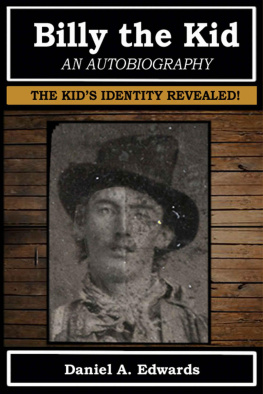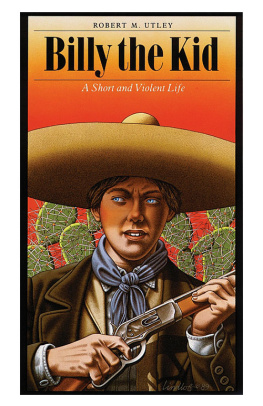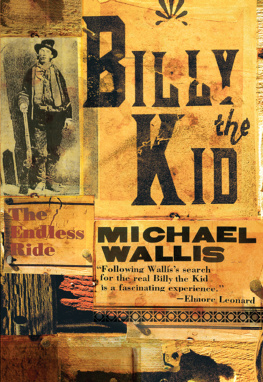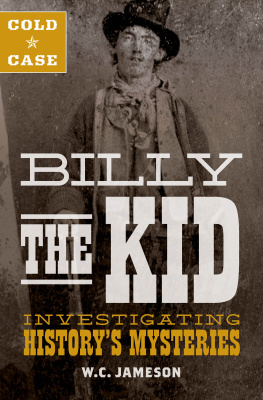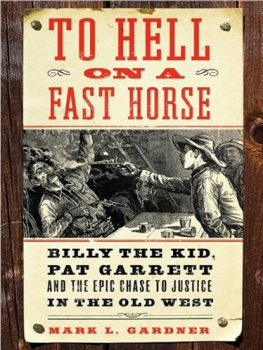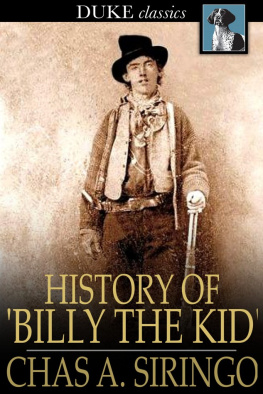
BILLY THE KID
An Autobiography
I want to die a free man
Copyright 2014
By Daniel A. Edwards
ALL RIGHTS RESERVED

Published by
CREATIVE TEXTS PUBLISHERS
BARTO, PA
www.creativetexts.com
Portions of this manuscript have been published previously in the book
Alias Billy the Kid
By
C.L. SONNICHSEN & WILLIAM V. MORRISON
PUBLISHED BY
UNIVERSITY OF NEW MEXICO PRESS
COPYRIGHT 1955
AUTHORS PREFACE
INTRODUCTION
CHAPTER 1: BRUSHY BILLS STORY
CHAPTER 2: THE FEUD BEGINS
CHAPTER 3: BLOOD IN THE STREETS
CHAPTER 4: TO BE HANGED BY THE NECK
CHAPTER 5: JAILBREAK
CHAPTER 6: DEATH BY MOONLIGHT
CHAPTER 7: FROM THEN TILL NOW
CHAPTER 8 : THE TANGLED WEB
CHAPTER 9: BE HE ALIVE, OR BE HE DEAD
CHAPTER 10: IN BLACK AND WHITE
A PAGE FROM AN INTERVIEW WITH BRUSHY BILL ROBERTS
EPILOGUE
APPENDICES
APPENDIX A: Governor Wallaces Proclamation
APPENDIX B: The Change of Venue
B.1. Rynersons Motion
B.2. The Supporting Affidavit
B.3. Change of Venue Granted
APPENDIX C: Billy the Kids Trial
C.1. The Missing Indictment
C.2. Request for Instructions by Defendants Counsel
C.3. Judge Bristols Instructions to the Jury
The Jury
1. The Verdict
2. The Sentence
3. The Death Warrant
4. The Sheriffs Return of the Death Warrant
APPENDIX D: The Report of the Coroners Jury
D.1. The Report (translation)
D.2. Letter from the District Attorney of the 4 th Judicial District
D.3. Letter from the County Clerk of De Baca County
D.4. Letter from the County Clerk of Guadalupe County
D.5. Letter from the Deputy District Clerk of the 4 th Judicial District
D.6. Letter from the Secretary of State of New Mexico
APPENDIX E: The Reward
E.1. Governor Wallaces Official Offer/ Governor Ritchs Refusal to Approve Garretts Application
E.2. The Legislative Act
APPENDIX F: Affidavits
F.1. Severo Gallegos
F.2. Martile Able
F.3. Jose B. Montoya
F.4. Dewitt Travis
F.5. Robert E Lee
AUTHORS PREFACE
In 1882 a notorious outlaw finally walked out of a New Mexico jail a free man. He had just completed serving a prison sentence for the murder of a Texas Ranger and decided prison was not for him. His debt to society paid, he walked out of the prison a free man and disappeared, never to be heard from againor so we were told.
The outlaw was Jesse Evans, founder of the notorious Jesse Evans Gang. This gang, that roamed New Mexico during the 1870s and 1880s, committed innumerable acts of armed robbery, violence and cattle rustling. Its members included such prominent western names as Frank Baker, Jim McDaniels and Curly Bill Brocius (among others) but no doubt the gangs most notable acquaintance was Jesses childhood friend; the legendary Billy the Kid.
Traditional history tells us that Billy the Kid was killed in 1881 and that Jesse Evans was never heard from again. The truth, however, is that there is more evidence against this position than we are led to believe.
In 1948 when the brother of Jesse Evans passed away and his estate needed to be settled, Jesse Evans re-appeared and revealed that he had been living in Florida under the alias Joe Hines. Joe Hines was able to prove to the satisfaction of a court of law that he was the one and only Jesse Evans of legend. You see, his brother had left a parcel of land to Jesse and he intended to get what was rightfully his, and he did.
Jesse told the lawyer handling the case that he was one of three surviving participants of the Lincoln County War. One of the other survivors, he claimed, was his childhood friend William H. Bonney, alias "Kid" Antrim, alias "Billy the Kid". This was a startling claim from someone who had himself been considered long dead and it was against the odds that two surviving old men, both who were of meager means, would have the methods or energy to correct the 70 years of established storyline that had developed around the disappearance of Jesse Evans or the exploits of Billy the Kid.
Nevertheless, the lawyer, William Morrison, contacted the Kid who was now himself living under an alias and approaching 91 years old. At first he was reluctant to share his story, especially since he was technically still wanted and condemned to hang for a crime he didnt commit. However, after some consideration he decided it was more important to make an attempt to secure the pardon he was promised more than 70 years earlier than it was to remain a fugitive outlaw hiding in the shadows. In the end, after a lifetime of hiding and running from the law, Billy wanted to die a free man.
Morrison learned that the Kids true name was not William H. Bonney, nor was it William H. Antrim. He had used many aliases over the years but his Christian name was William H. Roberts and he had the family bible to prove it. The Kids story was remarkably normal. He discussed the events of the Lincoln County War and some of his infamous shootouts, but he also spoke equally as proudly of his skill as a cowhand and bronc buster. He spoke with deep emotion regarding his friends who had been killed and filled in many details of the times that had escaped the historians of the time and were only found out to be true many years later.
He also provided physical evidence of his identity, both on his own body and in the form of artifacts, and was even able to procure five signed affidavits from surviving witnesses who personally knew Billy the Kid that supported his claim. He spoke to these people in person and was recognized by all of them (and more). When they spoke together they were able to speak conversationally about the old days, each reminding the other of specific events when they were together as old friends do. After these meetings they were each individually and collectively certain that this man was Billy the Kid.
Morrison prepared his evidence and brought the ninety year old Billy the Kid before the Governor of New Mexico to obtain his pardon. In the end, however, the Governor made a media circus and a mockery of the proceedings and used it as a publicity stunt rather than treating it as a serious legal matter. It was thus that the testimony of two genuine living legends was discarded for the convenience of popular history as they chose to accept it. Discarded perhaps, discredited for a time, but not before their story was told in full.
William H Roberts, aka Billy the Kid personally collaborated on his autobiography with William V. Morrison and you are now invited to sit down with him and listen as he tells his story once and for all. Mr. Roberts was a treasure trove of first hand testimony regarding life in the Wild West. Like all credible living witnesses of the period he would have no doubt been widely pursued and quoted if it were not for the fact that he claimed to be Billy the Kid.
Many men have from time to time come forward to claim that they were famous historical figures. No one, however, has ever been able to do so with the mountain of evidence that Mr. Roberts was able to provide that he was, in fact, the authentic Billy the Kid of legend. In addition to the signed affidavits from living witnesses that had known the Kid, his physical characteristics the two men shared (including gun and knife wounds), and photographic and physical records that William Henry Roberts had in his possession at the time, Mr. Roberts matched exactly the description of Billy the Kid, including height, weight, eye color, and stature. All of these evidences were available at the time to support his claim. However, despite these things no one of his era except Mr. Morrison was willing to investigate them during his lifetime.
Next page
